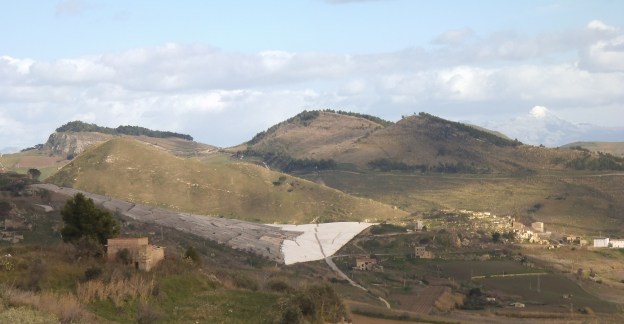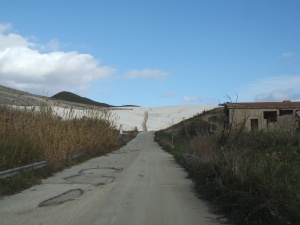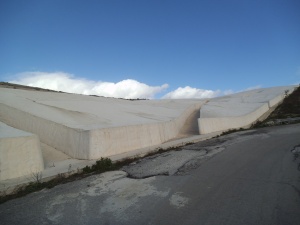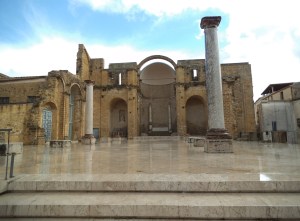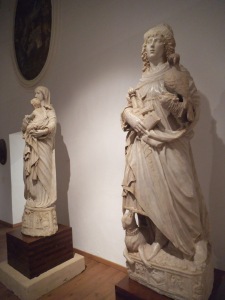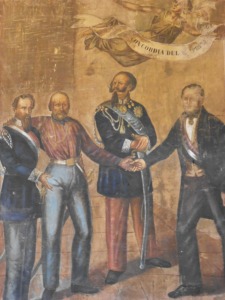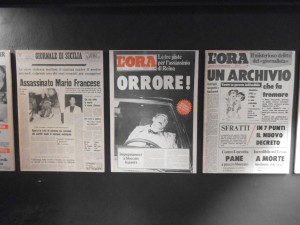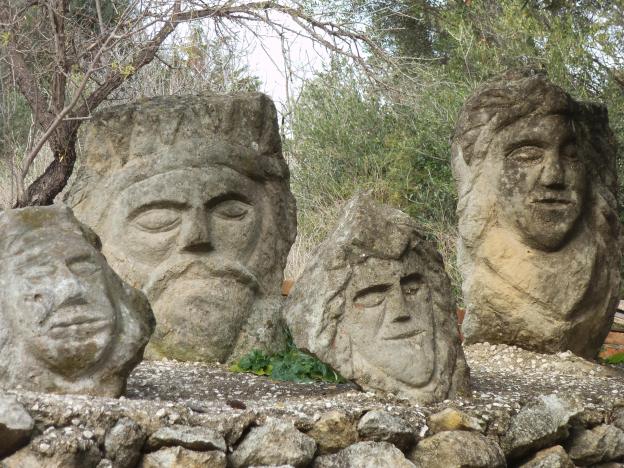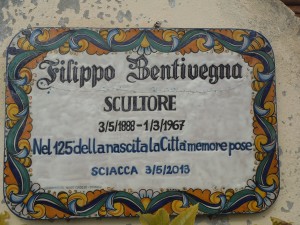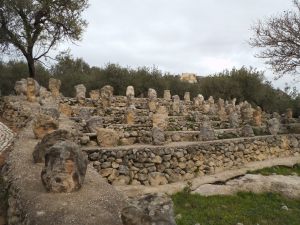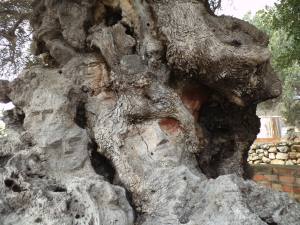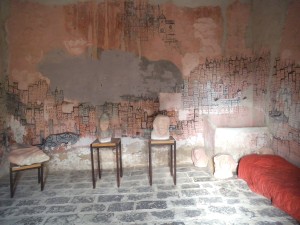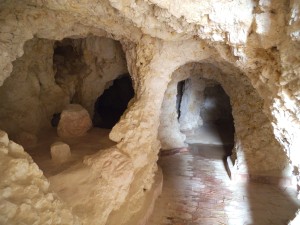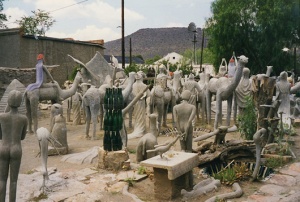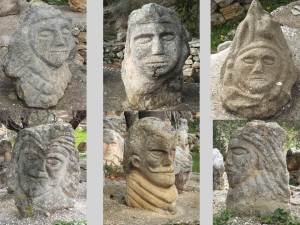 It’s hard to visit Barcelona without bumping into Gaudi. Even the aire where I am staying is next to Gaudi’s Crypt, the unfinished church which was designed by Gaudi and built for the textile workers of Colonia Guell. But was he a genius or a madman? I decided to find out.
It’s hard to visit Barcelona without bumping into Gaudi. Even the aire where I am staying is next to Gaudi’s Crypt, the unfinished church which was designed by Gaudi and built for the textile workers of Colonia Guell. But was he a genius or a madman? I decided to find out.
My plan was simple: to visit the exteriors of all the Gaudi designed sites in Barcelona using the metro and my own two feet. While researching, I came across a FREE Gaudi walking tour, operated by Runner Bean and decided that the additional information that could be provided by a knowledgeable local guide would be invaluable, so I immediately booked online.
 It’s 10.45 and I easily find my guide in Placa Reial. He’s very tall, wearing a luminous green vest and holding an equally bright green umbrella. Marc greets everyone with a smile, while his colleague checks us off on her list and brands us with a small numbered sticker, red for the Gaudi tour and green for the visit to the Gothic Quarter. The Gaudi group are multinational, with representatives from Holland, Poland, France, Korea, Brazil, Canada and the USA.
It’s 10.45 and I easily find my guide in Placa Reial. He’s very tall, wearing a luminous green vest and holding an equally bright green umbrella. Marc greets everyone with a smile, while his colleague checks us off on her list and brands us with a small numbered sticker, red for the Gaudi tour and green for the visit to the Gothic Quarter. The Gaudi group are multinational, with representatives from Holland, Poland, France, Korea, Brazil, Canada and the USA.
 We start our visit in Placa Reial where the ornate lampposts were the first, and only, public city commission which Gaudi received. While we admire them, Marc gives us some background information on the famous architect. He was born in Reus in 1852 and was a vegetarian for most of his life. A fierce Catalan nationalist, he preferred to speak only in Catalan and, as a young man, he had petitioned for the Monastery of Poblet to be restored and used as a commune for artists and writers.
We start our visit in Placa Reial where the ornate lampposts were the first, and only, public city commission which Gaudi received. While we admire them, Marc gives us some background information on the famous architect. He was born in Reus in 1852 and was a vegetarian for most of his life. A fierce Catalan nationalist, he preferred to speak only in Catalan and, as a young man, he had petitioned for the Monastery of Poblet to be restored and used as a commune for artists and writers.

A short hop across Las Ramblas and we find ourselves in front of one of Gaudi’s early masterpieces. Palau Guell was commissioned by the wealthy industrialist Eusebi Guell who became a long term patron of Gaudi, offering him projects with unlimited resources. The Palau was built in the 1890s but the family were kicked out during the Spanish Civil War and the building was later given to the city in 1945, being declared a UNESCO World Heritage Site in the 1980’s. The exterior is very dark and austere, with only the colourful chimneys poking above the rooftop suggesting a more playful design.

 We take to the metro for a two stop ride to Passeig de Gracia where several modernista facades await us. Gaudi’s Casa Batllo is the most striking, with its unusual balconies and rooftop tiles. There is some debate over the symbology. The balconies could be masks suggesting a happy carnival theme. However, more people subscribe to the story of George and the Dragon, with the tower representing the knight’s lance, the roof tiles are the dragon’s scales and the balconies are the skulls and bones of the victims. Gaudi was originally commissioned by Josep Batlló i Casanovas to renovate an existing building on the site. The house is now owned by the Bernat family who are known for the manufacture of Chupa Chups lollipops.
We take to the metro for a two stop ride to Passeig de Gracia where several modernista facades await us. Gaudi’s Casa Batllo is the most striking, with its unusual balconies and rooftop tiles. There is some debate over the symbology. The balconies could be masks suggesting a happy carnival theme. However, more people subscribe to the story of George and the Dragon, with the tower representing the knight’s lance, the roof tiles are the dragon’s scales and the balconies are the skulls and bones of the victims. Gaudi was originally commissioned by Josep Batlló i Casanovas to renovate an existing building on the site. The house is now owned by the Bernat family who are known for the manufacture of Chupa Chups lollipops.



On the same block are two other modernista buildings: Casa Amatller and Casa Lleo Morera. It is possible to enter the ground floor of Casa Amatller to admire the beautiful staircase and stained glass ceiling without having to pay. There is also a chocolate shop and café inside which is very appropriate as the building is owned by a family of chocolatiers.


 A short walk along the pavement, which features seafloor designs by Gaudi, and we find ourselves in front of Casa Mila, better known as La Pedrera. Built in 1906, Gaudi used a revolutionary technique of structural columns to enable a more open plan design for the interior apartments. The exterior is quite austere with its limestone façade and wrought iron balconies. Apparently, Mrs Mila, whose fortune was used to finance the construction, was not very happy with the design, along with many Barcelona locals. The rooftop features some unique chimney designs, including one which supposedly inspired George Lucas’ characterisation of Darth Vader. Marc told us of one long-term inhabitant called Carmen who has benefited from rent control, paying only €500 per month to stay in such an iconic building.
A short walk along the pavement, which features seafloor designs by Gaudi, and we find ourselves in front of Casa Mila, better known as La Pedrera. Built in 1906, Gaudi used a revolutionary technique of structural columns to enable a more open plan design for the interior apartments. The exterior is quite austere with its limestone façade and wrought iron balconies. Apparently, Mrs Mila, whose fortune was used to finance the construction, was not very happy with the design, along with many Barcelona locals. The rooftop features some unique chimney designs, including one which supposedly inspired George Lucas’ characterisation of Darth Vader. Marc told us of one long-term inhabitant called Carmen who has benefited from rent control, paying only €500 per month to stay in such an iconic building.


 Another metro ride brings us to the final stop on our tour, La Sagrada Familia. Gaudi was a very religious man and the design and build of this church was his life’s passion. Construction began in 1882 and it is anticipated that it will not be completed until at least 2026. Founded by the donations of sinners (or tourists), it receives over 3 million visitors each year.
Another metro ride brings us to the final stop on our tour, La Sagrada Familia. Gaudi was a very religious man and the design and build of this church was his life’s passion. Construction began in 1882 and it is anticipated that it will not be completed until at least 2026. Founded by the donations of sinners (or tourists), it receives over 3 million visitors each year.

The nativity façade was completed by Gaudi before his death in 1926 when he was hit by a tram. Thought at first to be a tramp, due to his dishevelled appearance, there was some delay in getting him hospital treatment, and by the time his friends realised what had happened he was already dying. He was buried in the crypt of his beloved church and immortalised by the architect Josep Maria Subirachs as a character in the passion façade.

All this walking has made me hungry so, following Marc’s suggestion, I head towards the St Pau Hospital in search of a restaurant with a good menu del dia. Just before I reach the Hospital, I find Firo Tast with an intriguing menu for €14.95. Inside, it reveals a rather posh décor and when my food arrives it is beautifully presented. Feta salad with strawberry dressing, garlic lamb chops and a light panna cotta for dessert. They are not stingy with the wine either.
 While enjoying my lunch I decided on a plan for the afternoon. Despite there being no queues for the Sagrada Familia I didn’t have a good enough camera to do it justice and besides, I’d just spent the entrance fee on lunch! Instead, I decided to take a quick look at the modernista hospital of St Pau and then take the metro to Parc Guell.
While enjoying my lunch I decided on a plan for the afternoon. Despite there being no queues for the Sagrada Familia I didn’t have a good enough camera to do it justice and besides, I’d just spent the entrance fee on lunch! Instead, I decided to take a quick look at the modernista hospital of St Pau and then take the metro to Parc Guell.

Marc had mentioned an escalator which assisted with the steep climb up to Parc Guell, but all I found was a never ending set of steps which brought me to the rear of the site. Although you now have to pay an entrance fee to visit the monumental area of Parc Guell, much of the surrounding park is still free and it’s possible to view quite a lot of Gaudi’s creations. Also, the views across the city are quite wonderful.




 From the park, I walk back downhill to Place du Lesseps, in search of one of Gaudi’s earliest creations. Unfortunately, when I locate Casa Vicens, I discover it is shrouded with scaffolding and in a state of renovation. The house was commissioned by stockbroker Manuel Vicens i Montaner and built between 1883 and 1888. Despite the scaffolding, I could see many of the decorative details, such as the iron fan palm railings and the tiles of yellow marigolds.
From the park, I walk back downhill to Place du Lesseps, in search of one of Gaudi’s earliest creations. Unfortunately, when I locate Casa Vicens, I discover it is shrouded with scaffolding and in a state of renovation. The house was commissioned by stockbroker Manuel Vicens i Montaner and built between 1883 and 1888. Despite the scaffolding, I could see many of the decorative details, such as the iron fan palm railings and the tiles of yellow marigolds.

The day is drawing to a close and, although I have managed to visit much of Gaudi’s work in Barcelona, I have still only just scratched the surface. However, it does give me a reason to return to the city and next time I’ll bring a better camera and perhaps venture inside some of the amazing houses and monuments of ‘God’s Architect’.
So, genius or madman? Probably a bit of both, but that’s usually the combination needed to become a great artist or architect.

Gaudi in Barcelona
Sagrada Familia 1882– [Completion estimated 2026–2028] – €15 (€22 with audioguide)
Casa Vicens 1883–1888 – closed for restoration
Güell Pavilions 1884–1887 – €4
Palau Güell 1885–1890 – €12
Teresian College 1888–1889 – still used as a school
Casa Calvet 1898–1900 – now houses a restaurant
Casa Figueres (Torre Bellesguard) 1900–1909 – €9 with audioguide or €16 guided tour
Park Güell 1900–1914 – €7
Casa Milà (La Pedrera) 1905–1907 – €20.50
Casa Batlló 1905–1907 – €22.50
Church of Colònia Güell – Santa Coloma de Cervelló (Barcelona) 1908–1914 – €9 with audioguide tour of village.
Sagrada Família Schools 1909 – used as offices for the Sagrada Familia construction.
Gaudi beyond Barcelona
El Capricho – Comillas (Cantabria) 1883–1885 – €5
Episcopal Palace of Astorga (León) 1883–1913
Casa Botines -León – occupied by Caja Espana Bank
Bodegas Güell – Garraf, Sitges 1895–1897 – now houses a restaurant
Artigas Gardens – La Pobla de Lillet 1905–1906 – €4.15
Other Modernista buildings in Barcelona
Casa Amatller – €15 (or 22.60 combined ticket with Casa Lleo I Morera)
Casa Lleo I Morera – €15 (or 22.60 combined ticket with Casa Amatller)
Hopital St Pau – €10 (or €16 guided visit)
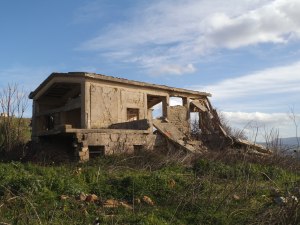 The road to the old town of Ruderi di Gibellina is so cracked and deformed that it is hard to imagine that the earthquake which flattened it occurred nearly 50 years ago. Up to 400 people died, a thousand were injured and 100,000 left homeless when the 5.5 tremor hit south west Sicily on the 15th of January 1968. The surviving inhabitants suffered even more until the new town was completed 12 years later nearly 20 kms away. Much delay was caused due to corruption and Mafia threats regarding building contracts.
The road to the old town of Ruderi di Gibellina is so cracked and deformed that it is hard to imagine that the earthquake which flattened it occurred nearly 50 years ago. Up to 400 people died, a thousand were injured and 100,000 left homeless when the 5.5 tremor hit south west Sicily on the 15th of January 1968. The surviving inhabitants suffered even more until the new town was completed 12 years later nearly 20 kms away. Much delay was caused due to corruption and Mafia threats regarding building contracts.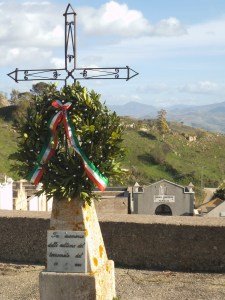 It’s a sunny day and I stop briefly at the cemetery of Ruderi di Gibellina, the only structure to have survived. A simple memorial remembers those who died on that dreadful day. The road winds down to the site of the former town, now almost completely covered in a layer of concrete, looking like a misplaced glacier. In fact, Alberto Burri’s modern art installation is named ‘IL Cretto’ (The Crevice) and the cuts in the concrete represent the positions of the roads that ran through the town. It’s almost as if the artist has sought to bury the pain of the past. However, a few derelict and crumbling buildings remain to serve as a reminder of what happened here 50 years ago.
It’s a sunny day and I stop briefly at the cemetery of Ruderi di Gibellina, the only structure to have survived. A simple memorial remembers those who died on that dreadful day. The road winds down to the site of the former town, now almost completely covered in a layer of concrete, looking like a misplaced glacier. In fact, Alberto Burri’s modern art installation is named ‘IL Cretto’ (The Crevice) and the cuts in the concrete represent the positions of the roads that ran through the town. It’s almost as if the artist has sought to bury the pain of the past. However, a few derelict and crumbling buildings remain to serve as a reminder of what happened here 50 years ago.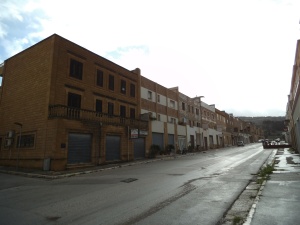 The following day, on the anniversary of the earthquake, I visit the new Gibellina. It is Sunday morning and the streets are empty, so I can drive around and check out the modern art which is dotted around the place. It’s clear that they applied lessons learned from the earthquake when they designed the new town. Houses and flats are only one or two storeys and the streets are very wide, but it is devoid of any real character and feels like a 1970s council estate. I wondered if there would be a memorial service at the church but perhaps it is too early as it is all locked up.
The following day, on the anniversary of the earthquake, I visit the new Gibellina. It is Sunday morning and the streets are empty, so I can drive around and check out the modern art which is dotted around the place. It’s clear that they applied lessons learned from the earthquake when they designed the new town. Houses and flats are only one or two storeys and the streets are very wide, but it is devoid of any real character and feels like a 1970s council estate. I wondered if there would be a memorial service at the church but perhaps it is too early as it is all locked up.
